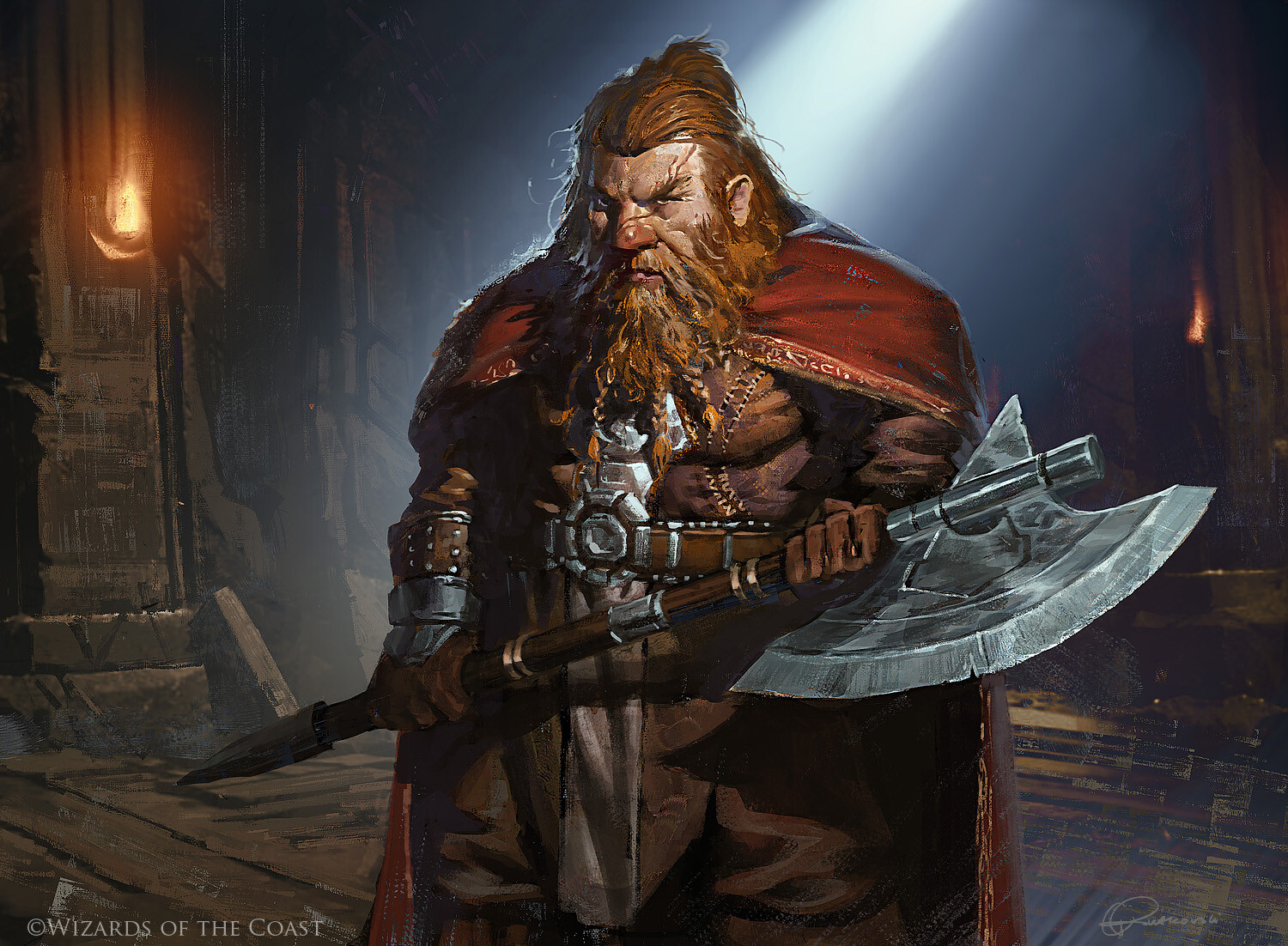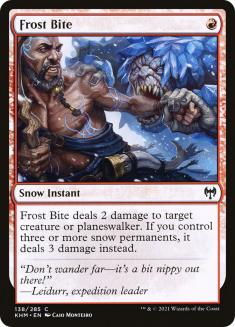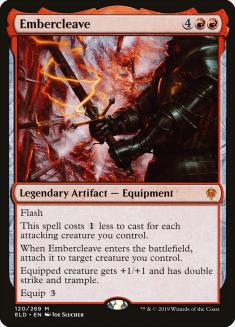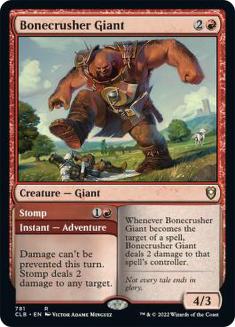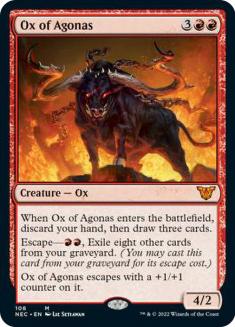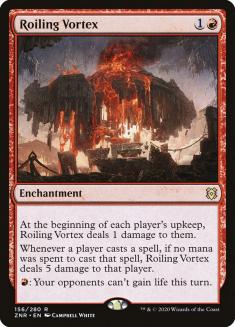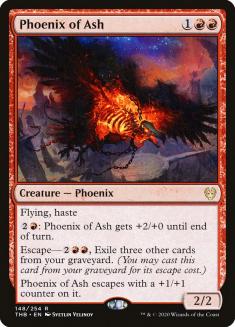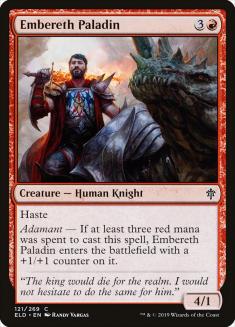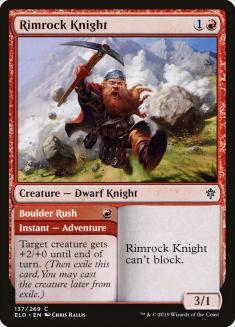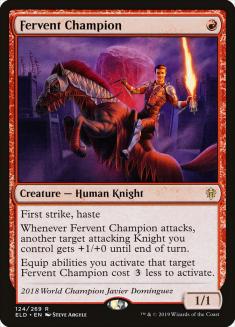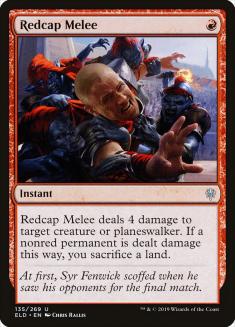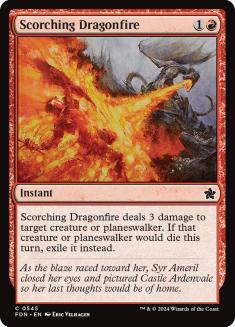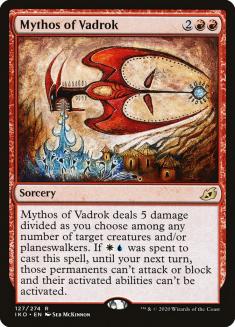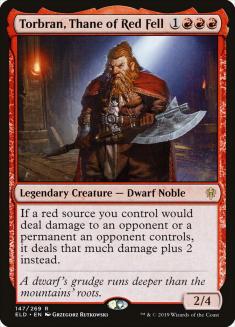We call him “The Dane.”
Creatures (28)
- 4 Robber of the Rich
- 4 Fervent Champion
- 4 Bonecrusher Giant
- 3 Torbran, Thane of Red Fell
- 4 Rimrock Knight
- 4 Anax, Hardened in the Forge
- 1 Phoenix of Ash
- 4 Fireblade Charger
Lands (23)
Spells (9)

Christoffer Larsen is an incredible specimen. Standing around six-and-a-half feet tall, The Dane towers over the competition both literally and figuratively. His stature is matched only by his boisterous personality and infectious laugh. He fills up the room with his smile. He can be a handful for anyone unfamiliar with his antics, but that’s the cost of having a big personality!
If you don’t know Christoffer Larsen, you should familiarize yourself. He’s a Limited nut. He’s a Magic guru. He masters everything he touches because he has a drive unlike anything I’ve ever seen. He also just so happens to lean aggro when it comes to Constructed, which is surprising considering most of the geniuses I know lean Cryptic Command over Lava Spike. But The Dane is cut from a different cloth.
Mono-Red Aggro❄ has been on the up and up over the last few weeks in Kaldheim Standard, which is good news for anyone named SandyDogMTG or Tom “The Boss” Ross. I expected a heavy dose in the $5K Kaldheim Championship Qualifier this past Sunday and I was not disappointed. As such, I built my Sultai Ramp (Yorion) to lean anti-aggro with a lot more spot removal and sweepers, moving away from the ramping aspects like Wolfwillow Haven. Even then, I found myself on the wrong side of an Embercleave now and again. It’s just a great deck that most people are having trouble hating out right now, including myself. So why fight it?
If we can’t beat ’em, let’s join ’em.
Burnin’ Down the House
Kaldheim Standard has been a rollercoaster. I found some initial success with Emergent Ultimatum in the Sultai Ramp decks, but Kaldheim Standard seems to be churning with a high frequency. Not only do the important cards keep changing, the metagame keeps evolving at a rapid pace. Most Gruul Adventures decks have incorporated white to include Giant Killer and Showdown of the Skalds. Aggro decks popped up to fight Sultai Ramp (Yorion), which in turn might make other midrange decks come back in a big way. Aggro’s stock is still rising and continues to be dominant in the face of being a known quantity, which is impressive for an archetype so linear in construction.
One thing to remember when playing Mono-Red Aggro❄ is that every point matters. Squeezing all the juice out of each card is important because you have fewer total resources than most of your opponents. Think of playing an aggro deck like trying to cook with some really hot peppers. Sure, they might be small, but they pack a wallop. It’s important you understand and respect all your game pieces when you pick them up. Combining two or three can lead to some really spicy turns. It just might not be filling to eat a bunch at once.
I hear the sentiment quite regularly that aggro decks are brainless, and that anyone can pick up the #1 aggro deck in a format and do well with it. Trust me, I’ve seen Ali Aintrazi pilot a Mono-Red deck and take a bashing. I watched him make a bunch of mistakes and ultimately lose because of those mistakes, all while blaming variance or flooding out. Anger and frustration often block out our ability to objectively analyze a game or match, or to just give a great deck its due.
I think the opposite is true. Any dummy can win a game of Magic by casting a Baneslayer Angel. It takes a special kind of person to win with Hordeling Outburst. It takes an even greater player and deckbuilder to understand both when and why an aggro deck is good. Switching to an aggro deck when you’re not comfortable with the archetype can be daunting, but anyone trying to win tournaments needs to have range. Being on top of the metagame and understanding how to play all archetypes will make you a more well-rounded player while simultaneously growing your intimacy and knowledge of each of those decks. When you fully understand a thing, when you can pull it apart and put it back together, that’s when you know you’ve truly mastered it and can defeat it.
Red Deck Wins Again
With all that out of the way, let’s get down to brass tacks. Winning with Mono-Red Aggro❄ can be difficult, but most of the tension comes from being a known quantity. When aggro decks don’t show up to tournaments, people stop playing removal, sweepers, and other types of interaction that can be troublesome for a creature-based strategy. When Mono-Red Aggro❄ wins a tournament, the next few weeks are usually full of decks trying to exploit that matchup. The time in which aggro is usually bad is right now, but that line of thinking is superseded when the cards inside the archetype overwhelm even the most prepared opponents.
When aggro decks win for the second weekend in a row, you know they’re probably good enough to hold their own in even the most hostile environments. Do y’all really think that the Sultai Ramp (Yorion) decks just didn’t play enough removal? Or maybe natural predators to low-ball aggro like Izzet Midrange❄ just stopped showing up because they were getting whomped by Lovestruck Beast? Lovestruck Beast decks tend to be a bit troublesome for Mono-Red Aggro❄, but were getting smashed by Sultai Ramp (Yorion), so it’s nice to see two decks falling off the radar as of late considering how popular they were just two weeks ago. It’s funny how quickly things change.
To be perfectly clear, you can’t go wrong playing The Dane’s list of Mono-Red Aggro❄. After playing with and against Mono-Red Aggro❄ a lot over the last week, I’ve come to a 75 I’m happy with. If you’re looking to get a leg up on the competition with Mono-Red❄ this weekend, look no further.
Creatures (28)
- 4 Robber of the Rich
- 4 Fervent Champion
- 4 Bonecrusher Giant
- 3 Torbran, Thane of Red Fell
- 4 Rimrock Knight
- 4 Anax, Hardened in the Forge
- 1 Phoenix of Ash
- 4 Fireblade Charger
Lands (23)
Spells (9)

Sideboarding
Sideboarding is often the most overlooked aspect of tournament success. Understanding the “why” as opposed to the “how” when it comes to sideboarding will often be the difference in an entire win at the end of a long day. As we all know, the difference between first place and ninth place after Swiss is rarely more than a single win, so upping your game by that one match win on average by understanding each of your matchups is huge. In this sideboard guide, I’ll go over the most-played decks at the moment and help you understand why I’m doing what I’m doing, and hopefully you can see those suggestions come to life as you play the deck and learn it up and down.
VS Sultai Ramp (Yorion)
This matchup is about going under your opponent. A single resolved Emergent Ultimatum is usually enough to close the door, but there are some situations where it just won’t be enough. Your goal is to end the game before they get to that point or put them in such a precarious position that no combination of two spells will get them back into the game before you bust them up on the next turn.
The Sultai Ramp (Yorion) decks are going a bit harder on the cheap interaction, but it seems like some are moving away from Elspeth’s Nightmare. That’s actually pretty great for you, but bad news for Rimrock Knight, which got some nice value from bricking one of their more ghoulish answers. Killing your early Robber of the Rich and then stealing your Embercleave was outrageous.
As someone who’s played a lot of Sultai Ramp (Yorion) in the Kaldheim Standard, beating Mono-Red Aggro❄ with even the best of draws can be quite difficult. Finding a lot of cheap interaction isn’t easy, and stumbling on mana in the early turns often leads to death. As the beatdown player, it’s your job to put up those threats as quickly as possible while looking for a spot to stick Embercleave or Torbran, Thane of Red Fell to close the door before they cast Emergent Ultimatum. If their answers line up correctly, they’re on the play, and/or they have some sick tech you’re unprepared for fundamentally (think Elder Gargaroth), things can get out of hand. As a deck full of cheap spells, we’re incapable of regaining that lost control.
They won’t put up much resistance by blocking, so our main form of damage will come from our first few creatures. Don’t try to sandbag them to gain extra value from the Adventure mechanic. It’s much more important that you just cast Rimrock Knight on the second turn if you have no other threats to cast. If you try to get that extra two damage out of Boulder Rush, chances are you’re going to miss out on a three-damage attack because it’s not already on the battlefield ready to attack!
Here’s how I sideboard.
Out:
In:
Threat density is not really a problem for us, so cutting some removal for a few threats isn’t at all necessary. We’re doing a combination of removing our worst or useless cards while also upgrading some of our threats with creatures that are specifically good against other matchups, but still solid here. Ox of Agonas and Phoenix of Ash shine against Dimir Rogues (Lurrus), but are great against removal-heavy opponents in general.
Roiling Vortex is huge here, giving you a way to stifle Emergent Ultimatum with the clause that everyone forgets about. If they fully cast Emergent Ultimatum, they take ten damage. In the meantime, they’re taking one a turn and you have the ability to shut down lifegain effects when they pop up. I’ve really missed Sulfuric Vortex lately but Roiling Vortex is a solid substitute. It’s really only for this matchup but can come in against any midrange or control deck that has a boatload of removal. The chip damage from Roiling Vortex is fine, but it’s even better in multiples.
Embereth Paladin shines like no other sideboard card I’ve seen for something that looks so bland. In actuality, it’s a big hasty threat that doesn’t die to Eliminate or Heartless Act. It’s the perfect threat after your opponent blows up all your creatures with a Shadows’ Verdict, which it also conveniently dodges. Would I play more than one? Maybe, but it’s pretty awkward in multiples. For now, I’m just happy that it’s been good!
We’re trimming two Embercleave because drawing more than one is virtually dead and even having one means your opponent is likely forced to just sweep and kill every single creature you cast. Instead of that second one rotting in hand the whole game, I’d like to replace one of your better cards with something a little more resilient to removal.
The true strength of Embercleave comes from breaking through a battlefield stall. It helps you win games that you have no business winning, but ruining combat math for your opponent is the key. If your opponent isn’t blocking much and their deck is full of cheap, instant-speed removal, Embercleave can be one of your weaker topdecks and should be on the list for “worst duplicate in recorded history.”
VS Mono-Red Aggro❄
The mirror match is often a hated thing, but some mirrors can be quite fun. The back-and-forth gameplay between two aggro decks can be sick. In Mono-Red VS Mono-Red, the cheap removal often leads to a stall in the mid-game that in turn becomes a topdeck war. I have recommended choosing to draw in the past in a similar situation, because trading resources often and cheaply means whoever has the most resources will probably win.
This is not one of those times. Being on the play makes all of your cards better, and is especially disgusting in a matchup where your opponent’s main form of interaction is blocking. We will not be blocking very much.
Cards like Bonecrusher Giant are incredible in the mirror because they offer you a multitude of desirable effects. Not only do you have a removal spell, \you get a threat. A single Bonecrusher Giant ensures you have a solid play on the second and third turn, so a mulligan doesn’t necessarily mean disaster. Overall, I would rate Bonecrusher Giant as the single most important card in the mirror, and anyone who draws two copies while another person draws zero should be at a distinct advantage.
Out:
In:
Going a bit more threat-light is solid here, as our opponents will likely be sideboarding in the same types of removal to make sure they don’t get run over in the early turns. The creatures we’re taking out are our worst against an opposing Fireblade Charger, which is surprisingly robust as both a blocker and target of removal. Because we’re reducing the raw count of our early threats, we’ll be playing more “Big Red”-style after sideboard with Ox of Agonas and Phoenix of Ash.
The sideboard games will be a knock-down drag-out brawl. Both players essentially toss all their removal and creatures in a bin and see who comes out on top. It can be frustrating to play those types of games because many of your plays are scripted, but the true masters will separate themselves from the plebs based on whether or not you draw Ox of Agonas when both players on are (E).
One thing to remember is that Redcap Melee isn’t that much more valuable than any other removal spell in the mirror, but it is a very cheap way to interact with some of the more expensive creatures. Some people might still have Goldspan Dragon, and in those cases holding it might be better than burning it early, even if you’re taking some chip damage from a one- or two-mana creature. You don’t want to fall too far behind, but holding good removal for good threats is an age-old idiom in Limited, and I think it holds true in one of the more Limited-esque matchups that pops up in Constructed. With that said, removal is removal is removal and you should just use your best judgment when choosing to burn Redcap Melee on anything other than Anax, Goldspan Dragon, or Torbran.
Mythos of Vadrok is okay here, but expensive and usually just trading one-for-one. Because of how weak it is against Embercleave, as well as the fact that you’re likely burning all your removal as soon as you draw it, the likelihood of killing more than one creature with Mythos of Vadrok is not worth all the time and mana it takes to get full value out of it.
VS Mono-White Aggro❄
After this past weekend’s events, I expect Mono-White Aggro❄ to grow in popularity and I wouldn’t exactly consider it a good matchup. Like any creature-based opponent, they’re vulnerable to cheap removal and Embercleave, which means either half of our deck could beat ’em up given the right set of circumstances. Anax plus Embercleave is like assembling Splinter Twin in this matchup because their removal is few and far between. The battlefield gets clogged and your easiest route to victory is slamming with one huge bastard wielding The Badass Axe of Legend™. With that said, I’ve already lost enough times to Alseid of Life’s Bounty with Sentinel’s Eyes to make me understand that I don’t really want to be playing against this deck too often.
The sign of a good deck is that your “bad” matchups aren’t really all that bad. Even though I’d say we’re unfavored against the good draws of Mono-White Aggro❄, you can still clown them if they stumble, they’re on the draw, or you have a sick curve that tops out with Embercleave. I think their deck preys on opponents who can’t handle combat, but navigating those tough attacks is where you gain your percentage points. Knowing how to use Rimrock Knight efficiently or figuring out when to swing with everything in a Hail Mary attempt to steal the game can make it close to an even matchup. Remember: the threat of Embercleave can result in some heinous blocks from the opponent, which in turn could swing the tide in your favor if the game is close. Don’t be afraid to use that fear to your advantage even when Embercleave isn’t in your hand.
Out:
In:
This is the reason for Mythos of Vadrok. They have so many cheap creatures that are relatively hard to kill that a single Mythos of Vadrok will almost always kill their two best. With that said, they have a host of protective elements, but Mythos of Vadrok kinda gets around that by spraying multiple bodies at once. Most of their creatures are similar in power and threat level, so taking down two or more with a single card can easily swing a game in your favor. It also means we get to use a hammer instead of a scalpel because no one card of theirs is that much better than any other.
Except Luminarch Aspirant. That thing can kick rocks.
Fervent Champion comes out because it fails to attack or block profitably on basically any turn. Our deck is full of creatures that punish opponents for not having creatures to block. Fervent Champion will be mediocre against most opponents with the ability to block it, which makes it a prime candidate to get cut whenever you sideboard in more removal and expect games to go much longer.
VS Dimir Rogues (Lurrus)
This matchup is relatively easy. It’s one of those “naturally favored” situations where your archetype just rolls them. They don’t have enough removal to contain your aggression, and your cheap burn of Frost Bite and Stomp take the wind out of their sails so their tempo plays aren’t as impactful.
As the game goes long, Into the Story could buy them enough resources, but they should be on the back foot early. Just be aware of the blockers they could cast and try your best not to give them free wins when they do get to block. Losing a creature in a spot like that might be the difference in winning or losing the whole game. Each threat you stick is a pivotal point for your side of the battlefield, as they compound and cause complications the longer the game goes. If they don’t immediately answer everything, they’ll spend most of the game playing catch-up or hoping their Soaring Thought-Thief gets a free meal.
Out:
In:
This matchup is won or lost entirely on the back of your early pressure. Late-game tools like Torbran and Embercleave are mediocre at best and detrimental at worst. Your semi-transformational sideboard plan featuring Ox of Agonas means you have great incentive to empty your hand quickly, as you’ll likely get a free Bedlam Reveler as your opponent mills cards from your library. Having too many situational effects like Embercleave can get you killed.
Like Faeries back in the day, or even Delver in other formats, their deck casts a few cheap threats and tries to ride removal and card draw to the end of the road. If you can clean up their early creatures with Frost Bite or Stomp, their life will be pretty difficult so long as you keep applying that pressure. Even Fervent Champion and Fireblade Charger get in on the action, doing some chip damage, soaking removal, and generally being a nuisance. You just have to know how to leverage your early threats so you can resolve some of your mid-game breakers.
VS Gruul Adventures
Lovestruck Beast is incredibly annoying. Everything else can be dealt with but overall I’d say this matchup is not favorable. Aggro decks that are slightly bigger tend to be advantaged against other aggro matchups, which is why you see a lot of aggro decks going that direction after sideboard. The days of sideboarding into four copies of Glorybringer should be proof of concept.
Slower threats that are harder to kill make specific types of removal awkward, and can ultimately win the game on their own. Planeswalkers dodge removal in a similar way, which is why you see many midrange or aggro decks sideboard in those types of sideswipe threats regularly. For Gruul Adventures, that advantage is built in naturally, and they actually tend to sideboard in the other direction, adding cheap removal and trimming a bit of the fat.
Gruul Adventures is currently on a downswing in popularity which is pretty great for us. I wouldn’t want to play against Lovestruck Beast with any amount of regularity.
Out:
In:
This is a matchup where Mythos of Vadrok can be solid to great against different types of threats. Trading one-for-one against Lovestruck Beast is mediocre but it gets the job done. Killing off two or three creatures in one fell swoop to clear the way for your small creatures is pretty damn solid. Either way, I think it’s better than Soul Sear, which is complete garbage due to the high casting cost for its static effect. Mythos of Vadrok is more expensive but shines in many more spots.
Frost Bite dealing three damage is one of the main reasons to play it over Shock. Being able to clear an opposing Kazandu Mammoth for one mana is big, but it does so much more than that. Alongside Torbran, Thane of Red Fell, a Frost Bite can deal with Lovestruck Beast or other huge creatures.
Many builds of Adventures are moving to Naya which is very good for you. Giant Killer isn’t great against you and the additional color they add means more lands entering the battlefield tapped and more draws that feature the wrong colors of mana. If Gruul Adventures becomes Naya Adventures as a default, we’ll be much happier. Red decks don’t really care about how much card advantage one can gain from Showdown of the Skalds. They care about killing you before those cards end up mattering!
The battlefield clogs here pretty easily, which means Embercleave is going to be at its peak. They’re a bit light on removal in the first game, but that might change a bit after sideboard. I still think you keep all your Embercleaves because it’s one of your best draws when you’re behind on battlefield or stalled out, but drawing one when you have no relevant creatures is one of the worst feelings in this type of matchup. If we had better answers to Lovestruck Beast, I might cut Embercleave in the matchup entirely.
Game Theory: Red in Standard
Having Embercleave be the ultimate play for red is toxic. It’s a weird card that steals games you have no business winning, but it also just stinks when your opponent eliminates all your early threats. It can be clunky and expensive and downright horrible in some spots. The second one is terrible, but that’s mostly because the first one usually just wins the game.
Torbran has always felt like more of a red finisher than Embercleave. In most iterations of red that feature Embercleave and Torbran, I tend to find myself hating Embercleave and loving Torbran because it has basically zero of those feel-bad moments. With that said, I can also see all the times in which Embercleave wins the game for me or my opponent, and it happens with staggering regularity.
Cards that create mostly negative emotions when drawn or cast, both for you and your opponent, are part of a strange batch. Magic cards that elicit such a response often do so because the gameplay experience they create is often jagged or one-sided in nature. Embercleave ending the game or resulting in a blowout whenever it’s cast is like the ultimate experience for someone who loves being disappointed.
I love playing aggro decks. I used to grind the ladder to Mythic with Experimental Frenzy. I’ve won thousands of dollars playing Rabble Red and the like. I enjoy the challenge that playing against a Mono-Red deck brings, and the pressure it puts on deckbuilders to respect it. I like that the games are fast and that you just dumpster people who don’t have a clue what’s going on. It’s an exciting feeling to completely and utterly dominate your opponent, and few decks can do it like Mono-Red can. Like many cards from Throne of Eldraine that are hanging around Standard in their senior year, Embercleave poses an existential threat that doesn’t really require an answer, but should elicit a conversation.
My hope is that, in the future, the pendulum swings closer to Torbran than Embercleave. Rewarding cross-play between spell types or a dedication to your color is important for establishing balance and maintaining color identity. Torbran is almost a perfect Magic card and I can think of few examples that more powerfully evoke a feeling of “being red.”
If you like playing aggro decks, pick this one up. Many of the cards are cheap and most of the rares will see some play outside of Standard. I hope this sideboard guide and my explanations for each of the top matchups do you some good. I think it’s a great choice for this weekend and could be the deck to beat for weeks to come.

